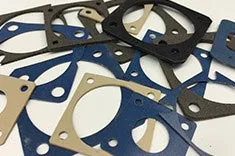EMI Shielding Products
- Custom Gasket Fabrication
- Connector Gaskets
- Bonded O Ring
- Custom Gaskets
- Conduct-O-Knit Knitted Wire Mesh
- Conduct-O-Seal Combo Gasket
- Conduct-O-Elastomer
- Conduct-O-Seal Oriented Wire in Silicone Gasket Material
- Conduct-O-Mesh Tape
- Conduct-O-Foam
- Conduct-O-Bond
- Optical Filters For Electronic Displays
- Shielded Vent Panels
- ESC Board Level Shielding
- 300 Series
Next-Generation Polymer-Based Shielding EMI
A Lighter, More Adaptable Way to Protect Your Electronics
 Have you ever spent hours designing a reliable enclosure only to realize that heavy metal plates were ballooning your project’s weight and cost? It’s a real letdown, mainly when everything else in your design checks the boxes for efficiency and performance. That sinking feeling often comes from knowing you either compromise on weight or give up dependable protection against electromagnetic noise. And for many, that’s not a decision they’re willing to make.
Have you ever spent hours designing a reliable enclosure only to realize that heavy metal plates were ballooning your project’s weight and cost? It’s a real letdown, mainly when everything else in your design checks the boxes for efficiency and performance. That sinking feeling often comes from knowing you either compromise on weight or give up dependable protection against electromagnetic noise. And for many, that’s not a decision they’re willing to make.
Yet there’s a better path for those seeking lighter, more adaptable solutions. Shielding EMI doesn’t have to hinge on bulky metals anymore. The growing use of conductive polymers unlocks new ways to protect sensitive electronics without pushing your build over its weight limit. When leveraged correctly, these flexible and corrosion-resistant materials can shoulder the burden of EMI shielding at a fraction of the mass normally associated with metal alternatives.
Lightweight Materials That Pack a Punch
Traditional metal barriers often feel like overkill—heavy, rigid, and prone to corrosion if conditions aren’t ideal. Polymer composites, on the other hand, can be tailored to offer impressive EMI shielding properties through specialized fillers like carbon nanotubes, graphene structures, or metal nanowires. Once dispersed throughout the matrix, these conductive additives create a tight network that blocks or absorbs stray signals. The result is robust protection without lugging around dense panels. Key Advantages of Polymer Composites:
- Reduced Weight: Less bulk translates to streamlined builds, which are significant in aviation or portable devices.
- Enhanced Corrosion Resistance: Where metals degrade, polymers endure, preserving consistent shielding over time.
- Flexible Designs: Complex geometries become simpler to shape and seal to quickly reinforce corners, seams, or even curved surfaces.
More Freedom for High-Performance Electronics
Engineers dealing with sensitive systems—from aerospace controls to consumer electronics—face constant pressure to ensure reliability. With polymer-based approaches, the absence of heavy metal frames liberates designers to think outside the box. Whether you’re racing to simplify a product’s form factor or aiming to future-proof your enclosure against new frequency interferences, a versatile polymer solution can be invaluable.
Not only that, but these unique composites can achieve high conductivity even at lower filler contents. In many setups, well-dispersed carbon fillers outperform metals in absorption-centric shielding EMI, making them great candidates for high-frequency challenges. For environments with extreme temperature swings or shock and vibration risks, the inherent elasticity of specific polymers can also help maintain a secure seal, preventing cracks or micro-gaps that sabotage EMI shielding effectiveness. Where it Fits and Why it Matters:
- Aviation and Space: Every ounce counts. Shifting away from large metal housings and using a polymer-based shield contributes to fuel savings and easier assembly.
- Medical Devices: In critical healthcare scenarios, enclosures that won’t corrode under regular sterilization routines and can keep signals pristine to avoid data errors are needed.
- Wearables and IoT: Consumer-driven gadgets thrive on small footprints and low power usage. Lightweight polymer shields ensure interference stays low without sacrificing comfort.
Even with the push toward polymer composites, some sectors may still occasionally rely on RFI shielding. Yet the principle remains: advanced materials can replace conventional options while improving overall performance and durability.
Streamlined Implementation of Shielding EMI with Expert Guidance
Adopting these emerging materials takes more than picking a random polymer off the shelf. Conductivity targets filler selection, manufacturing processes, and every detail matter for delivering consistent EMI shielding results. That’s why partnering with a knowledgeable resource pays off.
At East Coast Shielding, we help identify the best formulations and designs to meet your project requirements. By tapping into our experience with conductive polymers, you can minimize trial-and-error phases, control costs, and accelerate your path to a reliable, lightweight design.



